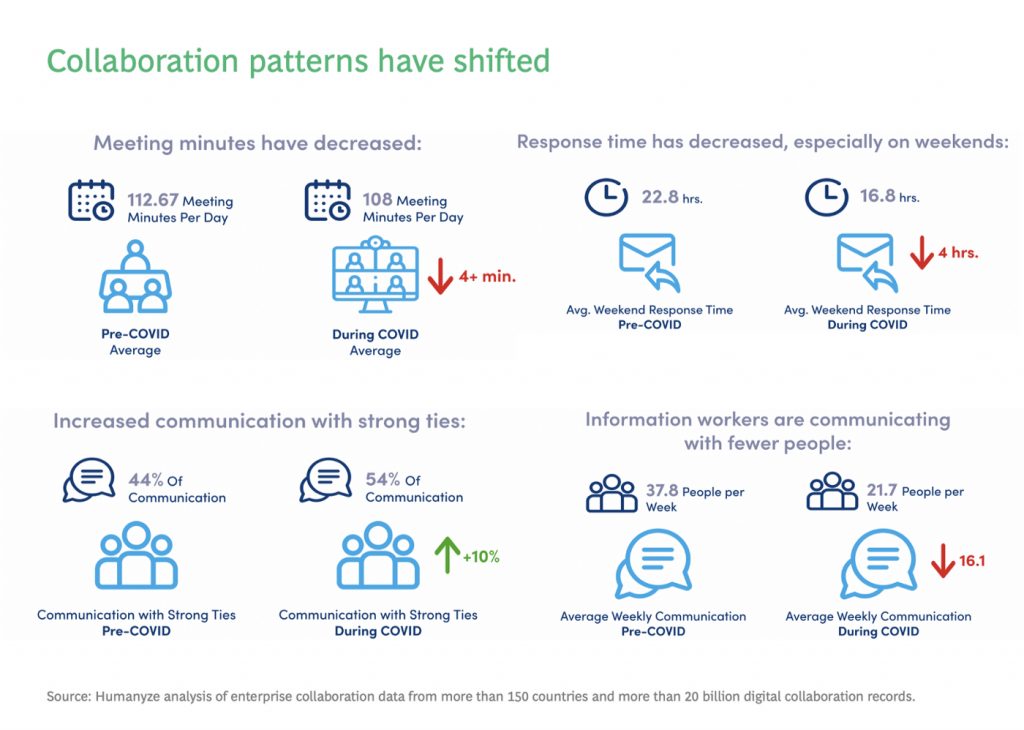In spite of fears of productivity and morale slumping when companies shifted to working from home, the transition was smooth for the most part. Many employees report a preference for the new arrangements: in a survey after the shift in working arrangements, more than half of workers said they would like to keep working from home for a majority of the time even after COVID-19 subsides. We probed beneath the surface of such headlines using the new science of workplace analytics and revealed some tradeoffs of working from home that will need to be addressed as companies contemplate extending and institutionalizing such arrangements.
The pandemic has disrupted the fabric of work across the board. In some areas it has laid bare and exacerbated stark inequalities. Minorities and those with the lowest incomes are at disproportionately higher risk of illness and death and are more likely to have lost their jobs. These people are more likely to have occupations that have been deemed essential, such as healthcare and service work, yet paradoxically are being dealt the harshest hand when it comes to the impact of COVID-19. Many literally put their lives on the line to do their job, with no guarantee that their job will continue to exist.
On the face of it, knowledge workers have been impacted to a much lower degree. Most can do their jobs from home, preserving both their health and more favorable employment conditions. Overall, their transition to remote work has been smoother than most imagined. Individuals report that they feel more productive — with the notable exception of parents juggling constantly shifting educational arrangements. Businesses also seem to favor the new model: according to a BCG survey, 93% of global companies indicate that they plan to permanently change remote work and meeting policies even after the epidemic is over, with 77% of companies expecting at least a tenth of their workforce to be remote even after the epidemic is over (compared to just 15% before it began).
But have we transitioned to a new fully sustainable way of working? Until recently, leaders have had limited ability to observe directly how collaboration and communication work in organizations. However, a new breed of workplace analytics tools enables us to observe and measure behavior at work directly for the first time. Using anonymized data from e-mail, calendar, chat, and other corporate systems, we can see how collaboration patterns are changing in real time across entire companies.
Humanyze, a start-up focused on workplace analytics, routinely collects such data across numerous global Fortune 1000 companies, allowing collaboration patterns to be compared before and during the epidemic. The data currently spans millions of workers in over 150 countries over a period of more than four years. Using this data, we can ask fundamental questions about the pandemic working environment:
- Have individual communication behaviors changed?
- What are implications for organizational communication networks as a whole?
- What are the implications for employees and organizations?
- Where do we need new policies to ensure the long-term effectiveness of remote work?
New collaboration patterns
Collaboration can be measured in two ways: meeting time, the amount of time spent in scheduled meetings with at least one other person; or communication time, the total amount of time spent across all communication channels (including e-mail and chat as well as meetings).
At first glance, work-from-home collaboration patterns appear little changed. Information workers have gone from a pre-COVID average of 112.67 meeting minutes per day to 108 meeting minutes per day. While only a reduction of about five minutes per day, considering the elimination in commuting times, this likely represents a significant increase in time available for other tasks.
Measuring communication time more broadly reveals a different aspects of the shift: people are spending 6.6% more time communicating across all channels. In particular, response times to messages are now significantly faster. Average response times are down 2.7 hours, with weekend response time seeing the biggest improvement (16.8 hours from 22.8 hours). This is consistent with people working the same number of hours but being “on” more frequently. Of course, with this comes the potential risk of burnout through not being able to set boundaries between work and leisure time.
Shifting networks
Beneath the aggregate totals of collaboration time, the data reveals significant shifts in who is communicating with whom. In particular, communication has become increasingly focused on strong ties, defined as individuals with whom a person communicates one-on-one for at least one hour per week on average. Strong ties represented 44% of communication pre-pandemic, but under a work from home regime they now constitute 54% of communication.
Meanwhile, interaction with weak ties and new connections is down by more than 20% over that same time span. As a result, the average information worker communicates with 16.1 fewer people per week (21.7 from 37.8).

Herein lies the core contradiction of our new working from home reality: these behavioral shifts may be efficient in the short term, as they focus more on pre-existing strong relationships which are more immediately useful, but this risks weakening the maintenance and growth of social capital in the long run.
Implications and remedies
These results indicate a number of areas of concern where organizational innovations are required.
First is the likely deterioration of new employee integration and its long-term impact on organizational effectiveness. New hires don’t have strong existing ties to draw on, so they’ll likely be stuck with formal interactions in structured sessions. At least in the short term, their networks will be dominated by these strong, formal ties, potentially leading to less personal growth and lower levels of promotion and decreased job mobility. The effect on their long-term prospects could be profound: employees who start when in-person work has resumed will be able to create more diverse networks, as will their more experienced peers. This may cause those who start a new job during the pandemic to fall significantly behind in their careers for the foreseeable future. Reinforcing this idea, JPMorgan CEO Jamie Dimon reportedly concluded that remote working particularly affected the productivity and creativity of the company’s youngest employees.
Such dynamics could lead to a stratification of employees more broadly. Those who already have relationships across the organization can continue to call on those ties and will likely be involved in more communication, while those on the periphery will be frozen out of conversations. This not only has personal implications for those individuals, but it is also likely to hurt cooperation across the organization as those on the periphery struggle to contribute. Moreover, both they and their collaborators will likely not even be aware that they’re contributing less than usual. Excluded individuals will likely have higher levels of stress and may even be at higher risk for depression, multiplying the mental health challenges associated with the crisis. Beneath the headline that many employees want to keep working remotely lies an underbelly of disenfranchised individuals whose ability to contribute is undermined by working from home.
A less connected and motivated periphery will also likely reduce organizational trust and creativity. Serendipitous interactions between dissimilar individuals are essential for effective problem solving. It’s not impossible to have serendipitous interactions in a remote setting, but the data shows that this won’t happen by default. Businesses that trumpet their successes here likely represent survivorship bias: no one talks about all the companies that have failed in this area.
All of these results point to the need to actively reinvent the work-from-home model for sustainability. Indeed, they may be compounded when there is more divergence in remote work policies within and across companies once the pandemic subsides. Not only will greater complexity mask the phenomenon, but polarization between co-located and remote employees may increase.
Companies will need to take a number of measures to counteract this risk of degradation of social capital. We are still writing the playbook for remote work, but these measures might include:
- Visualizing and tracking network health using new tools, data and metrics
- Creating non-goal focused meetings to build space of socialization and informal interaction
- Varying the format of “affiliation” events to maintain freshness and engagement
- Creating new meeting norms to ensure greater inclusivity than might naturally occur based on short-run efficiency considerations
- Placing special emphasis on apprenticeship, pairing up novices and experts in more structured programs
- Tracking the mental health of employees (as some companies have already begun to do) and paying attention to vulnerable subsegments in addition to overall averages
- Creating digital “nudges” based on real time analytics for employees who have become disconnected
While new video collaboration tools have been the heroes of the Covid crisis, the quieter revolution in workplace analytics may have an equally profound impact by enabling managers for the first time to visualize and manage communication and collaboration patterns in a granular and real time fashion.



